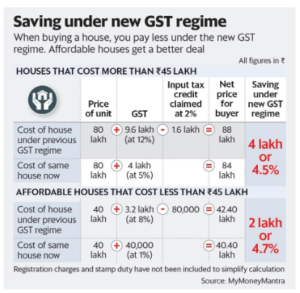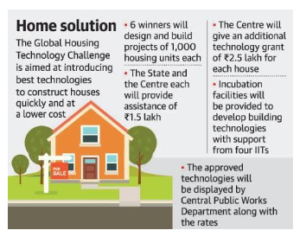All India Radio
Incentives to Boost Housing Sector
Search 15th September 2019 Spotlight here: http://www.newsonair.com/Main_Audio_Bulletins_Search.aspx
TOPIC:
General Studies 1
- Social Issues, Urbanization, their problems & remedies
General Studies 2
- Government policies and interventions for development in various sectors and issues arising out of their design and implementation.
- Welfare schemes for vulnerable sections of the population by the Centre and States and the performance of these schemes.
Housing is a fundamental requirement of human existence. The requirement of shelter is so basic that in common parlance in India, it is clubbed together with food and clothing as the troika of basic human needs of roti, kapda, and makaan. It is no wonder that housing is a key social demand, and a priority area for governments, both at the Centre and the states.
Real estate developers are expected to deliver over 4.5 lakh affordable housing units in the coming 15 months, claims a research report by PropTiger.com. With the vision of providing housing for all by 2022, the new government has rolled out various measures to boost the sector in the last few months.
- Notably, during the union budget announcement, the government increased the tax deduction limit on the interest paid on home loans by Rs.1.5 lakh to Rs.3.5 lakh annually, in cases where the unit price does not exceed Rs.45 lakh.
- To boost affordable housing in urban India, the Union budget earlier this year proposed a new model tenancy law – an attempt to handle the currently fragmented rental housing market.
- PMAY (U) envisages to be implemented during 2015-2022 through assistance from the Centre to urban local bodies or other state-level agencies. The execution is done through four verticals — rehabilitation of existing slum dwellers using land as a resource through private participation, credit-linked subsidy, affordable housing in partnership, and subsidy for beneficiary-led individual house construction or enhancement.
- Under PMAY (Gramin), the target number of houses to be constructed by the year 2021-22 is 2.95 crore. In the first phase, one crore houses were taken up for construction in three years between 2016 and 2019. In the second phase, 1.95 crore houses are targeted for construction between 2019 and 2022. The government provides Rs 1.5 lakh to each eligible beneficiary to construct a house under PMAY (G).

All India Radio (AIR) IAS UPSC – Incentives to Boost Housing Sector
How pricey is India’s urban rental market today, and how does affordability vary across major cities?
A Mint analysis of rental housing data across India’s top six metros (Delhi, Mumbai, Kolkata, Chennai, Hyderabad and Bengaluru) shows that Hyderabad has the cheapest rents on average ( ₹11,000) and Mumbai has the most expensive rents ( ₹38,200). These values are for a 650 sqft apartment, the rough size of a one bedroom-hall-kitchen (BHK) apartment.
One reason why this has not become a major political issue yet is that tenants are still a minority across India’s largest cities. Across Delhi (including all districts of the city), Mumbai (including Mumbai and Mumbai Suburban districts), Kolkata, Chennai, Hyderabad and Bengaluru, 60% of residents live on properties they own, according to the 2011 census.
What are the challenges?
- Low participation from private real estate development
- Increasing construction cost on account of lack of bulk sourcing of materials
- Unavailability of land in prime areas
- The faulty bidding mechanism
- The government will need another ₹1 lakh crore in three years to build one crore houses, as disbursements under PMAY-U show a huge lag. A ramp-up in fund-raising and utilisation is crucial.
- The success of the housing schemes depends largely on how active the states and urban local bodies are. The Union government provides the funds and they are spent by the states and urban local bodies. Some states are active and some may not be very enthusiastic about it because of political reasons
- Right now, the challenge before the government is to double the speed of construction in order to complete the remaining 6.6 million houses before March 2019. To achieve this target, the Centre has to nudge states such as Assam and Bihar, which have been lagging behind in implementing the scheme.
- Social Disconnect: Among the reasons mentioned above, it is observed from studies that the feel of disconnect and loss of social connections is a major reason for the beneficiaries to reject the housing provided by the government.
- Psychological Support: The relocation under housing schemes leads to a feeling of isolation. Social relations and community provides them a sense of support and comfort for the troubled days. Those residing in slums seek and provide a lot of psychological and material support from each other which the State cannot provide.
- Financial Comfort: Slum dwellers rely on each other for their borrowing needs in a regular manner. Moving to new areas also impacts their earning capacity and labour force participation.
- Socio-Economic Development: There is a greater need to understand what the individuals moving to a new place will gain or lose and what will be there response to the shift. This is because it is mentioned as a result of studies that benefits give the best results only if the people are made to relocate at an early age. Hence, a targeted approach is very important.
What are the solutions?
Roping in the private sector under the Public-Private Partnership (PPP) model: Among other initiatives, the government needs to
- Grant infrastructure status to the entire real estate industry making long-term financing easy for the industry
- Fix GST rate for all types of housing at 6%
- Revise carpet area to 60 sq. mt including in metro cities (to qualify for subsidy)
- Make land available at subsidized rates in metros and tier 1 cities so that the projects can be viable;
- Reduce premium on additional FSI (floor space index) to encourage affordable housing within metro cities
- Reduce time taken and cost of permissions and clearances
- Work on the mass housing model, bringing economies of scale into the picture
Reward developers for last mile connect
- Availability of land in cities at affordable pricing is one of the major challenges. The government could facilitate the development of affordable housing by making surplus land held by PSUs (Public Sector Undertakings) available for affordable housing projects. Also, local government’s property that is no longer useful can be monetised by selling to developers.
- The central government should guide the states on programmes to allocate and incentivise the usage of land for affordable housing, while also incentivising state governments to facilitate engagement and implementation.
- It is also recommended to incentivise developers for infrastructure and last mile connectivity development in semi-urban centres. It can be in the form of an increase in FSI or reduction in stamp duty or tax, and others. Infrastructure upgrading precedes the FSI increase to ensure that existing households are not adversely impacted due to the new development
Note:
Land: State subject

All India Radio (AIR) IAS UPSC – Incentives to Boost Housing Sector
Refer: Mindmap
Connecting the Dots:
- A house is a security that allows every individual to flourish under a sense of dignity. Elucidate. Also examine the significance of the Pradhan Mantri Awas Yojana in ensuring the social dignity of an individual.
- Providing affordable housing to all in India seems to be an ambitious target to achieved by 2022. Discuss the challenges and the way out.
- Government schemes do not only face implementation or structural challenges but are also subject to social challenges. Discuss. Suggest a strategy for overcoming social challenges in policy making and implementation.
- Is the PPP model in housing infrastructure viable option? Critically analyse.













